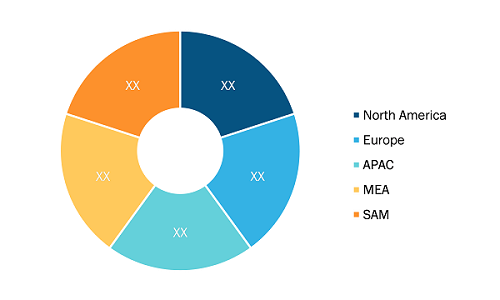The global driving training simulator market size is expected to reach US$ 2,646.73 million by 2028, registering a CAGR of 4.6% from 2022 to 2028, according to a new research study conducted by The Insight Partners.
Adoption of Simulator for Police and Emergency Vehicles
Advanced technologies, such as 3D visualization and 360-degree views, are specially incorporated into driving simulators created for categories with unique driving training simulation requirements. Police, military troops, firefighters, and ambulance drivers receive urgent and effective training from professional defense, police, and ambulance simulators.
Driving Training Simulator Market Share – by Region, 2021

Driving Training Simulator Market Report | Size, Share by 2028
Download Free SampleDriving Training Simulator Market Forecast to 2028 – COVID-19 Impact and Global Analysis – by Simulator Type (Compact Simulator and Full-Scale Simulator), Vehicle Type (Car Simulator, Truck and Bus Driving Simulator, and Others), End User (Driving Training Center, Automotive OEM, and Others)
These simulators ensure training solutions for crew and vehicle safety, mission stress, speed, barriers, traffic dangers, and road users to improve the proficiency of emergency reactions from drivers and passengers. The popularity of these simulators is progressively growing on a global scale. For instance, to increase road safety and lower traffic accidents in Oman, the Royal Oman Police (ROP) chose Tecknotrove's TecknoSIM driving simulators in December 2020. The TecknoSIM driving simulators will be modified to include Oman-specific traffic laws and regulations. In 2021, these driving simulators were installed at 11 driver instruction and testing facilities throughout Oman.
Similarly, in April 2020, the Department of State granted an IDIQ contract for the Republic of Mexico to VirTra, Inc., a global supplier of training simulators for the military, law enforcement, academic, and commercial markets. The contract had a US$ 1.6 million value. In the coming years, numerous state police academies and detention centers in Mexico will receive VirTra Driver Training Systems (V-DTS). Thus, the rising uptake of simulators in police and emergency vehicles is expected to drive the driving training simulator market during the forecast period.
The major stakeholders in the global driving training simulator market ecosystem include component providers, driving training simulator manufacturers, government organizations, regulatory bodies, and end customers. Component and hardware providers provide various components and parts to manufacturers. After the manufacturers, several peripheral stakeholders in the global driving training simulator market play a crucial role in enabling technological advancements and adopting simulators. Several industries are using advanced driving simulators due to their technologies, such as 360º viewing angle and motion platform, for a realistic experience. Since testing technologically updated vehicle dynamics requires an augmented environment for analysis and research, advanced driving simulators help develop intelligent highway designs and human behavior studies. These factors are likely to drive the driving training simulator market.
The driving training simulator market has been analyzed based on the following segments simulator type, type, vehicle type, end user, and geography. Based on simulator type, the market is segmented into compact simulator and full-scale simulator. The full-scale simulator segment is expected to dominate the market during the forecast period. Based on vehicle type, the market is segmented into car simulator, truck and bus simulator, and others. The car simulator segment is expected to dominate the market during the forecast period. Based on end user, the global driving training simulator industry is segmented into driving training center, automotive OEM, and others. The driving training segment is expected to dominate the driving training simulator industry during the forecast period. In terms of geography, the driving training simulator market is divided into five regions—North America, Europe, Asia Pacific, the Middle East & Africa, and South America. North America dominated the overall market in 2021, and Europe contributed to the second-largest market share in 2021.
Impact of COVID-19 Pandemic on Driving Training Simulator Market
The COVID-19 pandemic negatively impacted the global driving training simulator market. Passenger vehicle and light commercial vehicle (LCV) manufacturers faced immediate consequences of the outbreak, which is likely to continue in the long term. Lockdown restrictions, forced to curb the spread of SARS-CoV-2, significantly affected supply chains, raw materials, import and export of driving simulators, electronic components, and production facilities. However, as the lockdown restrictions eased since Q1 of 2021, the market has gained momentum due to the rising demand for vehicles.
The pandemic resulted in an economic slowdown, affected the supply chain, and impacted financial terms in firms. The impact can be felt in the automotive industry with lockdowns, restrictions, and suspension of production operations due to social distancing norms. Many companies faced a shortage of skilled workforce and delayed R&D investments to keep their operations running amid the COVID-19 pandemic.
Autosim AS, Cruden B. V., Dallara, ECA GROUP, IPG Automotive GmbH, Moog Inc., NVIDIA Corporation, Tecknotrove, and VI-grade GmbH are the key players operating in the driving training simulator market. In addition, several other market players have been analyzed to understand the driving training simulator market.
Contact Us
Phone: +1-646-491-9876
Email Id: sales@theinsightpartners.com